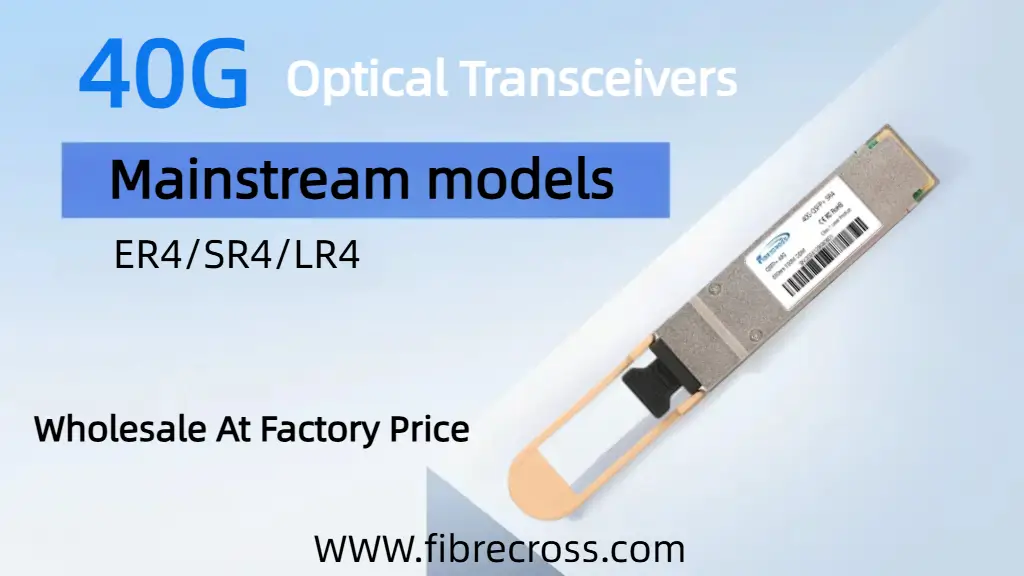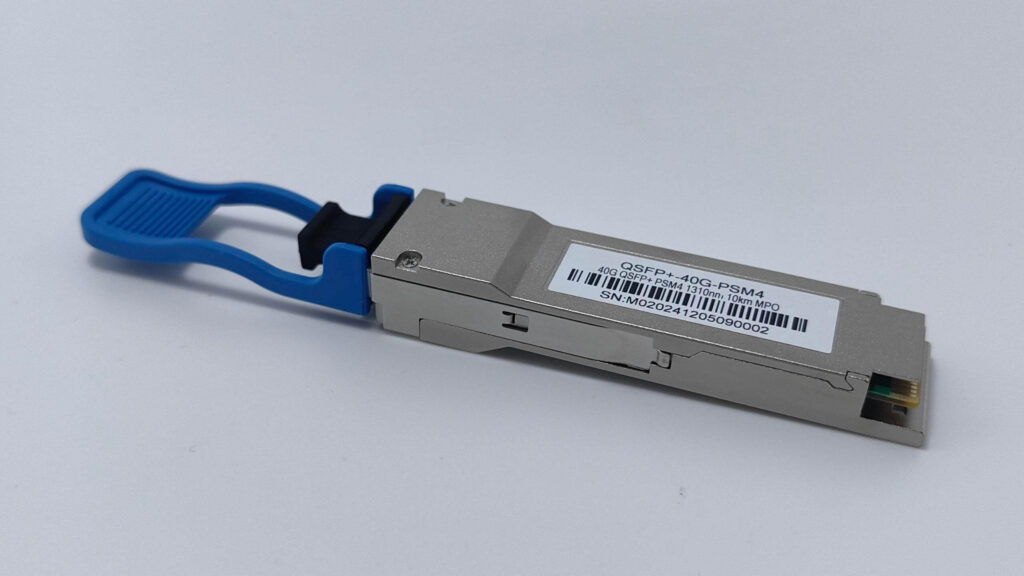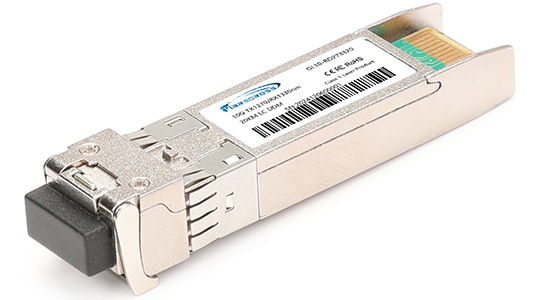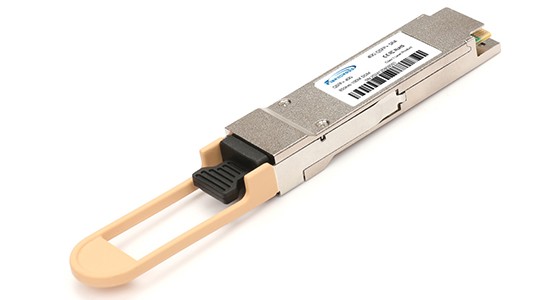The Power of 40G QSFP+ Optical Transceivers in Modern Networks
High-bandwidth demands in cloud, AI, and telecom have driven many IT networks to migrate to 40G Ethernet links. The 40G QSFP+ optical transceiver – often called a 40g fiber optic transceiver – is a hot-pluggable, high-density module that bundles four independent 10Gbps channels into a single 40Gbps link.
Each channel can:
Connect to another 40G QSFP+ module
Break out to four 10G SFP+ links
This quad-channel design gives data center switches and routers a higher port density than traditional 10G SFP+ ports. Crucially, these 40g transceiver modules support multiple standards (Ethernet, Fibre Channel, InfiniBand, SONET/SDH) and come in several variants (SR4, LR4, ER4, etc.) to cover different distance needs.
In short, 40g optical transceivers are the workhorses that bridge today’s 10G infrastructure to evolving 100G/400G fabrics, providing high throughput in a compact, cost-effective form.
Key 40G QSFP+ Variants and Performance
40G QSFP+ transceivers come in short-range (SR) and long-range (LR/ER) versions optimized for different fiber types and distances.
Common Types:
| Variant | Fiber Type | Connector | Max Distance |
|---|---|---|---|
| 40GBASE-SR4 | MMF (OM3/OM4) | MPO | ~100m (OM3), ~150m (OM4) |
| 40GBASE-CSR4 | MMF (OM3/OM4) | MPO | ~300m (OM3), ~400m (OM4) |
| 40GBASE-LR4 | SMF (OS2) | LC | Up to 10km |
| 40GBASE-ER4 | SMF (OS2) | LC | Up to 40km |
There are also:
PSM4 modules (8-fiber ribbon for 10km)
SWDM4/BiDi solutions with specialized optics
Technical Features:
40Gbps rate
850nm (SR4 on MMF) or 1270–1330nm (LR4 on SMF)
Digital Diagnostics Monitoring (DDM)
Hot-swap QSFP+ form factor
Plug-and-play interoperability via IEEE/MSA standards
These 40g qsfp+ optical transceivers deliver 4×10G in one module with lower power per bit than four separate 10G units.
Deployment in Data Centers and Enterprise Networks
Modern data centers often use spine-and-leaf architectures with high-speed uplinks. In practice, 40g qsfp+ transceivers are widely deployed to connect switches, routers, and storage.
Common Applications:
Leaf-to-Spine Links: 40G uplinks using SR4 or LR4 modules
Top-of-Rack (ToR): Cisco QSFP-40G-SR4 for intra-rack or short-reach links
Breakout Cables: 40G QSFP+ to 4×10G SFP+ connections
InfiniBand Fabrics: Low-latency connectivity in HPC clusters
These transceivers carry both:
North-South Traffic: Between aggregation/core layers
East-West Traffic: Within racks/pods or between servers
Even though hyperscale data centers are moving toward 400G, many enterprises still use 40G QSFP+ for its:
Compatibility with existing 10G infrastructure
Flexibility in breakout deployments
Cost-efficiency and physical space savings
Cabling and Connectivity Considerations
Structured cabling is critical for 40G links.
Connector Types:
40GBase-SR4:
12-fiber MPO/MTP connector
4 Tx + 4 Rx fibers
40GBase-LR4 / ER4:
LC duplex connectors
CWDM signal transmission over 2 fibers
Deployment Tips:
Match the transceiver with fiber type and reach (OM4 vs. OS2)
Use MPO-terminated ribbon cable for parallel optics
Use breakout cables to convert 40G to 4×10G
Consider SWDM or BiDi if backward compatibility is needed
When designing a deployment, IT architects must consider:
Distance (up to 150m on MMF, 10km+ on SMF)
Connector interface (MPO vs. LC)
Fiber type (OM3, OM4, OS2)
Use Cases in Telecom and Carrier Networks
Beyond data centers, 40g transceivers are widely used in telecom and carrier networks.
Carrier Applications:
Metro/Campus Aggregation: 40G SR4 or CSR4 for high-speed local connections
Wide-Area Backbones: LR4/ER4 for 10–40km fiber runs
Mobile Backhaul: Used in 5G edge and transport networks
SONET/SDH/OTN Compatibility: Flexible across telecom standards
40G QSFP+ also fits into legacy transmission equipment and can support:
ISP interconnects
Tiered backbone layers
Central office or POP aggregation
Compatibility and Network Upgrades
One of the main advantages of the 40G QSFP+ optical transceiver is interoperability and upgrade flexibility.
Highlights:
IEEE/MSA-Compliant: Interoperates across most vendor platforms
QSFP28 Compatibility:
QSFP+ modules can be used in QSFP28 (100G) ports
Supports 40G auto-negotiation
Breakout Capability:
Use fan-out cables to split 1×40G → 4×10G
Ideal for aggregation or phased upgrades
Even as newer transceiver formats like OSFP and QSFP-DD emerge, QSFP+ remains a foundational and compatible option for legacy and modern infrastructure.
Cost-Effectiveness and Sourcing
For IT buyers, 40g qsfp+ transceivers are not only high-performance but also cost-efficient.
Example Pricing:
| Transceiver Type | Generic Price | OEM Price |
|---|---|---|
| 40GBASE-SR4 | ~$35 | ~$80–100 |
| 40GBASE-LR4 (10km) | ~$285 | ~$338 |
Wholesale Benefits:
Bulk pricing discounts
Availability of refurbished or compatible parts
Warranties and support from 3rd-party vendors
Mixed SKU ordering for diverse deployments
Operational Savings:
Reduced rack space
Lower power consumption
Simplified cabling
All of which drive total cost of ownership down compared to using four 10G ports for the same aggregate bandwidth.
Choosing the Right 40G QSFP+ Transceiver
Here’s what to consider when selecting the right module for your network:
Selection Checklist:
Distance & Media
SR4/CSR4 for MMF (up to 400m)
LR4/ER4 for SMF (up to 40km)
Connector Type
MPO for parallel (SR4/CSR4)
LC duplex for CWDM (LR4/ER4)
Breakout Capabilities
Only MPO-based SR4/CSR4 modules support breakout to 4×10G
Compatibility
Verify switch/router support
Choose tested and validated optics
Power & Thermal Efficiency
Look for low-power variants
Vendor Reliability
OEM vs. third-party vs. refurbished
By reviewing your network’s cable plant and growth strategy, you can make the most cost-effective and reliable transceiver choice.
Conclusion
40G QSFP+ optical transceivers offer IT buyers a powerful blend of:
Performance: 40Gbps in a compact hot-swappable format
Density: Consolidates four 10G ports into one
Flexibility: Broad reach options from 100m to 40km
Compatibility: Interoperable across OEM and 3rd-party platforms
Affordability: Wholesale 40g qsfp+ optical transceivers lower total costs
As connectivity demands rise across enterprise and telecom, 40g optical transceivers continue to provide a reliable, scalable solution for next-generation high-speed networks—bridging today’s infrastructure to tomorrow’s performance needs.
FAQs About 40G QSFP+ Optical Transceiver:
40G optical transceivers use fiber optic cables and offer longer reach (up to 40km) and higher flexibility in routing and distance. In contrast, 40G DAC cables (Direct Attach Copper) are used for short distances (typically ≤7m) and include fixed transceivers on both ends. Transceivers are preferred for longer or more scalable deployments in modern data centers.
Yes. Certain 40G QSFP+ transceivers like 40GBASE-SR4 support breakout functionality. When used with MTP-to-4xLC breakout cables, one 40G port can connect to four separate 10G SFP+ devices, making 40g qsfp+ transceivers ideal for cost-effective aggregation and scalable design.
Many network hardware providers and manufacturers, including Fibrecross, offer wholesale 40G QSFP+ optical transceivers at competitive prices. Buying in bulk is ideal for enterprise data center builds or telecom infrastructure upgrades, significantly reducing per-unit cost while maintaining quality and compliance.
When selecting a 40G fiber optic transceiver, consider transmission distance (SR4 vs. LR4), fiber type (multimode or single-mode), connector (MPO or LC), breakout needs, and compatibility with your switch or router. Power consumption and warranty support are also key for long-term reliability.
A 40G QSFP+ optical transceiver is a compact, hot-pluggable module that combines four 10G lanes into one 40Gbps Ethernet interface. It works by transmitting and receiving high-speed optical signals through either multimode or single-mode fiber, depending on the variant (SR4, LR4, etc.). It’s widely used in data centers and telecom networks for high-bandwidth switch-to-switch or switch-to-server connections.






